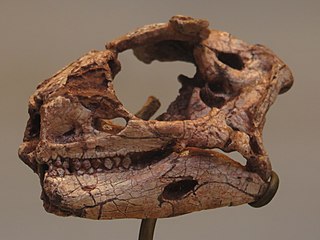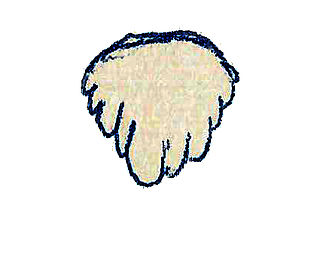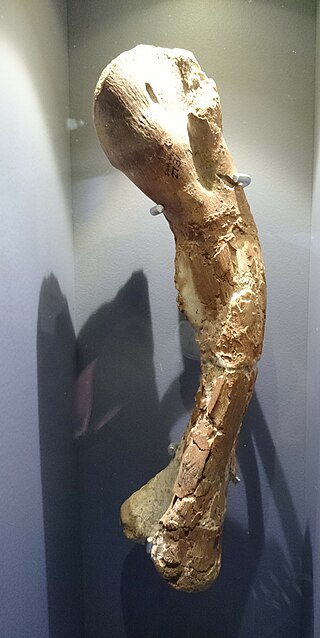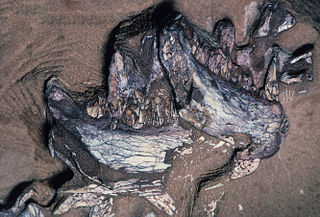
Lesothosaurus is a monospecific genus of ornithischian dinosaur that lived during the Early Jurassic in what is now South Africa and Lesotho. It was named by paleontologist Peter Galton in 1978, the name meaning "lizard from Lesotho". The genus has only one valid species, Lesothosaurus diagnosticus. Lesothosaurus is one of the most completely-known early ornithischians, based on numerous skull and postcranial fossils from the Upper Elliot Formation. It had a simpler tooth and jaw anatomy than later ornithischians, and may have been omnivorous in some parts of the year.

Melanorosaurus is a genus of basal sauropodomorph dinosaur that lived during the Late Triassic period. An omnivore from South Africa, it had a large body and sturdy limbs, suggesting it moved quadrupedally. Its limb bones were massive and heavy like the limb bones of true sauropods.

Abrictosaurus is a genus of heterodontosaurid dinosaur that lived during the Early Jurassic in what is now in parts of southern Africa such as Lesotho and South Africa. It was a bipedal herbivore or omnivore and was one of the most basal heterodontosaurids. It was approximately 1.2 metres (3.9 ft) long and weighed between 0.68 and 3 kilograms.

Massospondylus was a genus of sauropodomorph dinosaur from the Early Jurassic. It was described by Sir Richard Owen in 1854 from remains discovered in South Africa, and is thus one of the first dinosaurs to have been named. Fossils have since been found at other locations in South Africa, Lesotho, and Zimbabwe. Material from Arizona's Kayenta Formation, India, and Argentina has been assigned to the genus at various times, but the Arizonan and Argentinian material are now assigned to other genera.

Echinodon is a genus of heterodontosaurid dinosaur that lived during the earliest Cretaceous of southern England and possibly western France in the Berriasian epoch. The first specimens were jaw bones named Echinodon becklesii by Sir Richard Owen in 1861, and since their original description only additional teeth have been discovered. The specific name honours collector Samuel Beckles who discovered the material of Echinodon and many other taxa from across England, while the genus name translates as "prickly tooth" in reference to the dental anatomy of the taxon.

Heterodontosaurus is a genus of heterodontosaurid dinosaur that lived during the Early Jurassic, 200–190 million years ago. Its only known member species, Heterodontosaurus tucki, was named in 1962 based on a skull discovered in South Africa. The genus name means "different toothed lizard", in reference to its unusual, heterodont dentition; the specific name honours G. C. Tuck, who supported the discoverers. Further specimens have since been found, including an almost complete skeleton in 1966.

Alocodon is a genus of ornithischian dinosaur known from multiple teeth from the Middle or Late Jurassic Cabaços Formation of Portugal, and also the Forest Marble and Chipping Norton Formations of England. A single species is known, A. kuehnei.

Blikanasaurus is a genus of sauropodomorph dinosaur from the late Triassic of South Africa. The generic name Blikanasaurus is derived from Greek, meaning "lizard from Blikana". The species name cromptoni is taken from the surname of A.W. "Fuzz" Crompton, an American paleontologist who led numerous field expeditions in Elliot Formation outcrop localities in South Africa. Blikanasaurus is only known from partial hindlimb bones that were recovered from the lower Elliot Formation (LEF) in the Eastern Cape.
Trimucrodon is a genus of ornithischian dinosaur from the Late Jurassic Lourinhã Formation of Portugal. The type, and currently only, species is T. cuneatus.

Gyposaurus is a genus of basal sauropodomorph dinosaur from the early Jurassic of South Africa. It is usually considered to represent juveniles of other prosauropods, but "G." sinensis is regarded as a possibly valid species.

Kangnasaurus is a genus of iguanodontian ornithopod dinosaur found in supposedly Early Cretaceous rocks of South Africa. It is known from a tooth and possibly some postcranial remains found in the early-Aptian Kalahari Deposits Formation. It was probably similar to Dryosaurus.

Phyllodon was a genus of small ornithischian dinosaur from the Kimmeridgian-aged Upper Jurassic Camadas de Guimarota Formation of Leiria, Portugal and possibly also the Bathonian-aged Chipping Norton Limestone of England. It may have been closely related to contemporaneous dinosaurs in North America.

Geranosaurus is a genus of heterodontosaurid ornithischian dinosaur from the Early Jurassic. The type and only species is G. atavus.
Gongbusaurus is a genus of ornithischian, perhaps ornithopod, dinosaur that lived between about 160 and 157 million years ago, in the Late Jurassic period. A small herbivore, it is very poorly known. Two species have been assigned to it, but as the original name is based on teeth, there is no concrete evidence to connect the two species. Its fossils have been found in China.

Heterodontosauridae is a family of ornithischian dinosaurs that were likely among the most basal (primitive) members of the group. Their phylogenetic placement is uncertain but they are most commonly found to be primitive, outside of the group Genasauria. Although their fossils are relatively rare and their group small in numbers, they have been found on all continents except Australia and Antarctica, with a range spanning the Early Jurassic to the Early Cretaceous.
Paleontology or palaeontology is the study of prehistoric life forms on Earth through the examination of plant and animal fossils. This includes the study of body fossils, tracks (ichnites), burrows, cast-off parts, fossilised feces (coprolites), palynomorphs and chemical residues. Because humans have encountered fossils for millennia, paleontology has a long history both before and after becoming formalized as a science. This article records significant discoveries and events related to paleontology that occurred or were published in the year 1975.

The Elliot Formation is a geological formation and forms part of the Stormberg Group, the uppermost geological group that comprises the greater Karoo Supergroup. Outcrops of the Elliot Formation have been found in the northern Eastern Cape, southern Free State, and in the eastern KwaZulu-Natal provinces of South Africa. Outcrops and exposures are also found in several localities in Lesotho such as Qacha's Neck, Hill Top, Quthing, and near the capital, Maseru. The Elliot Formation is further divided into the lower (LEF) and upper (UEF) Elliot formations to differentiate significant sedimentological differences between these layers. The LEF is dominantly Late Triassic (Norian-Hettangian) in age while the UEF is mainly Early Jurassic (Sinemurian-Pliensbachian) and is tentatively regarded to preserve a continental record of the Triassic-Jurassic boundary in southern Africa. This geological formation is named after the town of Elliot in the Eastern Cape, and its stratotype locality is located on the Barkly Pass, 9 km north of the town.

Manidens is an extinct genus of heterodontosaurid dinosaur from the Early Jurassic of Patagonia. It is a sister taxon of the closely related Pegomastax from South Africa. Fossils have been found in the Cañadón Asfalto Formation in Chubut Province, Argentina, considered to be originally dated to the Bajocian, latter were found to be from Toarcian beds.

Pegomastax is a genus of heterodontosaurid dinosaur that lived during the Early Jurassic of South Africa. The only known specimen was discovered in a 1966–1967 expedition in Transkei District of Cape Province, but was not described until 2012 when Paul Sereno named it as the new taxon Pegomastax africana. The genus name is derived from the Greek for "strong jaw", and the species name describes the provenance of Africa; it was originally spelled africanus, was corrected to africana to align with the gender of the genus name.


















